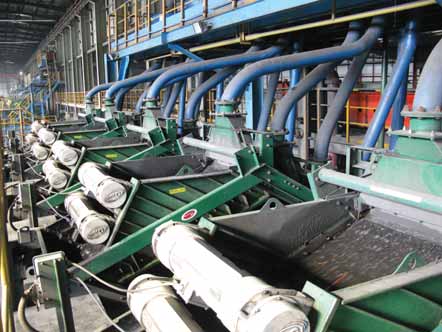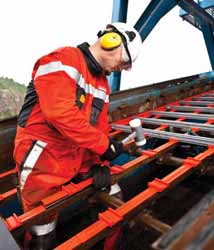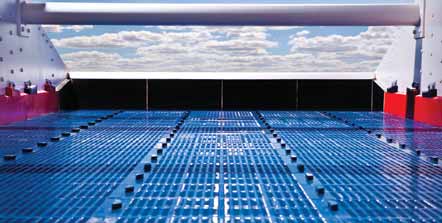
A bank of Tenova Delkor belt linear screens, designed for efficient trash removal in CIP/CIL plants.
On Deck: Screens for all Processes
Accuracy, durability and longevity—key features that screen operators demand
By Simon Walker, European Editor

According to Kurt O’Bryan, Weir Minerals’ global product manager for screen and screen media products, screening and screen media are the most important processes in any crushing or comminution plant. “Choosing the proper size and media material will make a big difference in efficiency and performance, so much so that making the wrong choice can be poison to the rest of the operation,” he said.
“In order for crushers to run correctly,” fines must be screened and removed before the material enters the chamber, otherwise packing occurs, which causes a high level of stress on the unit,” he said. “The screen size and selected screen media have to screen efficiently without plugging or blinding.”
O’Bryan added that ore size is another consideration in the choice of media materials. “If the ore is large and has the potential to cut urethane, customers will prefer to use heavier, cut-resistant rubber media decks,” he said. “In the case of other mining operations, as in quarry operations where there is constant changeover to meet aggregate specifications, wire screen media seems to be a more common choice because it is generally quicker to change than either rubber or urethane screen media.”
Special Screens for
CIP Plants
WesTech Engineering offers media retention and linear screens for use in CIP and
CIL gold-recovery plants. The company
explained that its media retention screen
allows for the use of larger tanks in plants
with higher production tonnage, without
the downtime and operating costs associated with earlier generations of screen.
Specific flow rates can be up to four times
greater than other screening methods, it
claims, noting that a screen can be
removed from its tank and a clean one
installed in its place in five to 10 minutes.
Meanwhile, WesTech said its linear screen has solved a major problem confronting CIP plants by removing wood fiber and tramp oversize from milled gold slurries. Capable of screening between 150 and 2,000 µm, these screens are working successfully in both gold mines and gold dump reclamation plants, removing more than 98% of the wood fiber and tramp oversize from slurries, compared with 40%-70% removal rates for other screening systems.

Features of the linear screen include a range of cloth apertures, with the cloth being made of wear-resistant polyester. There are no high-cost moving parts, and the cloth can be changed within 20– 30 minutes. The unit is simple to operate, and has low power consumption and low maintenance costs, with no vibration, WesTech reported.
Material Matters
Weir Minerals offers a wide range of heavyduty screen media utilizing rubber, urethane and wire materials, as well as
polyurethane and wire combinations marketed as its Linatex brand. The company’s
range also includes punched and plasmacut screens as well as wear liners, wear
parts and accessories.
The company’s Kurt O’Bryan told E&MJ that its Armor screen urethane-wire combinations offer the best of both worlds. “If a customer comes to us with a special need, we’ll customize a system to fit,” he said.
An operator’s choices of screen media depend on many variables, and efficiency, performance and maintenance are important, albeit in different ways, O’Bryan added. “Weir Minerals has always put R&D and product innovation at the forefront of its goals. We are constantly conducting research on elastomers and elastomer technology to develop new types of rubber, as well as other innovative ways to engineer new products that will improve our mining customer’s productivity. A great deal of what we are doing goes along with our M-2 mantra, Material Matters. Because it does.”
Jöst Handles Challenging
Materials
Screening technology is at the heart of
Jöst’s product line for primary industries,
with materials handled ranging from hard
rock and sand to coal and all types of ore.
For difficult-to-screen products, the company has special machines such as its Oscilla
flip-flow screen or its Grecco rod screen.
An international leader in vibration technology, Jöst said its 95-plus years of experience gives it the skills needed to meet any customer’s requirements.
One example of its expertise is a threedeck screen, delivered earlier this year. Designed to process limestone using salt water for wet screening, the unit weighs some 17 metric tons (mt), and measures 8 m long, 3 m wide and 3.6 m high. The screen features special design details and coatings to ensure reliability over a long operational life, Jöst said.
Telsmith: Multiproduct
Screens
Part of the Astec Industries group, Telsmith
offers a range of horizontal and inclined
screens. Its horizontal screens have a low
profile that is ideal for road portability
on rubber-tired or track-mounted plants,
according to the company, with units available in sizes ranging from 1.5-m × 4.9-m
up to 2.4-m × 6.1-m triple deck. They can
be equipped for wet or dry screening, and
can accept a variety of screening media
including wire cloth, urethane or rubber.

The Telsmith 820 Track screening plant has a throughput of up to 907 mt/h and can easily be operated by wireless remote control, the company says.
Telsmith’s Vibro-King TL inclined screens are available in sizes ranging from 1.5 m × 4.3 m up to 2.4 m × 7.3 m, and are used for heavy-duty scalping of coarse stone to fine sizing of finished products, in both wet or dry processing. Meanwhile, the company noted that its Valu-King screens have standard features not normally available in these screen sizes, which range from 1.2-m × 2.4-m single deck up to 1.8-m × 4.9-m triple deck. Valu-King models are used for finish sizing, medium-duty scalping and product rinsing.
Telsmith recently introduced a track processing solution with the 820 Track Screening Plant. This includes an 8203 TL screen, 1.4-m feed conveyor and 1.8-m under-screen conveyor, all combined to process up to 907 mt/h and produce up to four products simultaneously.
Increasing Capacity and
Throughput
Major Wire Industries reported that its
Flex-Mat 3 panels have more open area,
providing up to 30% more screen capacity
than traditional woven wire and up to 50%
more than polyurethane and rubber panels.
It employs independently vibrating wires
that increase product throughput by up to
40% by increasing the open area and eliminating blinding, pegging and clogging.
The company said the most commonly used versions for mining and industrial minerals applications are the modular 305-mm-square and 305- × 610-mm (1-ft × 2-ft) panels. These allow for precise spec material passing for up to half of the wire’s life, Major Wire added.
On modular screen decks, Flex-Mat 3 Modular panels are easy to install, either to replace existing polyurethane and rubber panels wherever throughput is compromised, or on the entire deck for maximum production. On tensioned screen decks, Flex-Mat 3 Tensioned uses polyurethane strips to hold individual wires in place, offering up to three times the wear life of woven wire because there are no cross wires to create high-wear points.

Intelligent Screening
Technology
Metso offers a three-model range of heavyduty inclined (banana) vibrating screens and
feeders for coal, iron ore, gold, silver and
copper mines worldwide. Its EF screens feature two separate but self-synchronizing
exciter mechanisms, while the use of
Metso’s SmartSpeed technology effectively allows the stroke angle to be adjusted to virtually stop material on the deck—enabling
cleaning without shutting down. This is
especially valuable in applications with
sticky material, the company noted.
Metso’s MF (Multi-Flo) screens offer multiple slope inclines that can affect the velocity of the material, enabling fines to separate quicker than on standard screens. Vibration is powered by linear exciters that are infinitely adjustable and deliver high throughput without blinding. Finally, its RF screens are smaller than the MF series, but function in the same way and are designed for lower-tonnage applications.
In terms of screen media, Metso has a complete offering from traditional wire media to lightweight rubber and polyurethane. The company’s flagship system, Trellex LS, is a modular system that is available in a standard range, as well as four “upgraded” versions. HiPer Flow offers 20% more active screening surface; HiPer Life is designed for maximum load and handling; HiPer Clean uses flexible rubber for its self-cleaning properties; and HiPer Drain has optimized openings to give the best dewatering efficiency.
“EF is an excellent example of what we describe as ‘intelligent screening’—we’re using advanced electronics and technology to better assist the customer in operating his plant,” said Robert Rutkowski, Metso’s global product line manager for vibrating mining equipment.
Polyurethane Preferred
Since 1978, Polydeck Screen Corp. has
been providing modular screening solutions
for the aggregate, coal and mining industries. The company said its extensive selection of screen panels, frame systems and
accessories has helped operators save
time, increase production, extend screen
service life and improve worker safety.
Polydeck’s screen media systems include the modular polyurethane Polydex line, available in 1-ft × 1-ft and 1-ft × 2-ft sizes in what the company claims is the most extensive range of opening sizes, shapes and configurations currently available. It also offers its Rubberdex line of 1- × 2-ft modular rubber screen media in several material compounds.
With Armadex, Polydeck recently expanded its product line to address the most abrasive, abusive scalping applications. This bolt-down rubber solution is available in screen section sizes up to 52 × 60 in. or 48 × 96 in., and can be made up to 4 in. thick.
The company cited an example where an eastern U.S. coal prep plant converted from wire to its synthetic screen media and extended wear life by more than 60% while cutting screen maintenance and labor costs by more than 40%. Polydeck supplied new rubber media for the plant’s scalping screens, and polyurethane media for the raw-separation and clean-coal drain and rinse screens.

Screens Replace Cyclones
Derrick Corp. reported that its patented
Stack Sizer provides unprecedented capacity in fine-particle wet screening while taking up a minimal amount of floor space.
The machine consists of up to five individual screen decks positioned one above the
other, operating in parallel, and with the
company’s high-capacity, long-life urethane screen media.
An example of the way in which a Stack Sizer can be used to replace hydrocylones in a grinding circuit comes from Soc, Minera El Brocal’s Tinyahuaco polymetallic mine in Peru. There, the company was evaluating increasing grinding capacity by adding a fourth ball mill to its circuit, which used a bank of 10 hydrocyclones for flotation feed classification.
According to Derrick, successful testwork carried out at its pilot plant in the U.S. led El Brocal to select two Stack Sizer units as a replacement for the hydrocyclones. Even with two of the three ball mills idle, production increased by 11% with a 9% gain in lead recovery, with El Brocal then increasing the capacity of its crushing and flotation circuits to absorb the new-found grinding capacity. With a further three Stack Sizers, and one of the ball mills restarted, plant throughput increased from 138 t/h to 245 t/h, the grinding circuit recirculating load was cut significantly, and slimes production was nearly halved.
New System Reduces
Blinding
Through its construction equipment division, Sandvik offers inclined, horizontal
and roller screens. The range encompasses
vibrating grizzlies and scalpers, three-way
split screeners, the world’s only range of
tracked doublescreens, and triple-deck
screens. Its crawler- and wheel-mounted
mobile units meet customers’ demands for
mobility, the company said.
Where screening media are concerned, Sandvik offers a performance warranty, guaranteeing the percentage of over- and under-sized particles in each fraction, with its low-noise screening media available in many designs and a wide range of thicknesses, aperture shapes and sizes.
According to Sandvik, its new WR media for use on screens with longitudinal profiles offer less blinding and reduced downtime. The key to the WR system is the optimization of screening accuracy, the company explained, with the modular screening media using a fiber-reinforced rubber screen membrane. This permits the use of thinner panels, with closer aperture spacing, thus maximizing the open screening area.
The absence of blind fields in the direction of material flow reduces carry-over, and the proportion of undersize in the final product, while Sandvik claims that the screen membrane has a larger open area than other modular systems, resulting in higher throughput capacity.

150 Years of Screening
Experience
Since 2012, FLSmidth has been supplying
Ludowici’s state-of-the-art vibrating screening equipment and complementary consumable and wear-resistant products and
services. The company noted that its
screening products offer a long life-span,
flexible configurations and maximum operational efficiency, and that it manufactures
some of the largest size screens available.
The Ludowici BRU linear motion vibrating screen is FLSmidth’s premium heavyduty screen design. This equipment has been built specifically for continuous operation under the harshest operating conditions. Available in horizontal, multislope and inclined versions coupled with single-, double- and triple-deck configurations, they range from 0.9 m to 4.8 m wide and up to 11 m long.
The Ludowici VSW heavy-duty, high-frequency dewatering screen has been specifically designed for the effective dewatering of fine coal and minerals, and can handle slurry containing fine particles from 0 mm to 4 mm.
FLSmidth is now also a major supplier in the mineral processing consumables market, supplying a complementary range of screen media including stainless steel, carbon steel, polyurethane, rubber and woven-wire screening systems.
Trash Screening and
Flood Prevention
According to the head of Tenova Delkor,
Heiko Teuber, the company developed its
belt linear screen (BLS) to solve the problem of effective trash removal in CIP/CIL
processing. BLS units are typically installed immediately after the mill discharge cyclone overflow to remove waste
and oversize ahead of a leach or flotation
circuit, and for carbon safety at the back
end of the leach circuit.
However, under a recent contract, its screening technology is entering new markets, with the supply of the first units to the oil sands industry. “Strong demand also continues from our traditional markets,” Teuber added, “with a contract from BEA Mountain Mining Corp. for its New Liberty gold project in Liberia including 9-m 2and 6-m 2 belt linear screens among other equipment.
The company has recently introduced a 40 m2 BLS to its range, which starts at 0.5 m2 , with most of its designs now containerized to reduce freight to mines in remote places.

Teuber told E&MJthat Tenova Delkor has also developed and patented a novel BLS flood-detection device, which detects when a waste-removal screen is overloaded and sends a signal to the screen’s drive motor. This then increases the cloth speed on the BLS to offer more open area to the slurry flow, thus mitigating the flooding.
“BLS flood detection is also invaluable in applications where it is common for milldischarge cyclones to rope, sending coarse material to the BLS. The system advises that the operation is roping, and assists in controlling it,” Teuber said.
Modular and Portable
Screen Plants
Trio Engineered Products builds a complete range of crushers, vibrating screens,
conveyors, and material-handling equipment that can be used on either portable or
modular platforms.
For stationary applications, Trio offers a wide range of pre-engineered modular platforms that help lower the cost of construction, installation and shipment. They are also re-locatable assets that represent the most economical way to build a stationary plant or add to an existing facility.
All Trio screens are manufactured with huck-bolted frames. Its inclined screens are available in both oil (TIO and TIOSP Series) and grease (TIH Series) lubrication configurations, depending on customer preferences. Sizes range from 4 ft × 10 ft to 8 ft × 24 ft, and are available in single-, two-, three- and four-deck arrangements.
Trio horizontal screens generate their power via three timed shafts with eccentric counterweights. The combination provides an oval stroke forward motion that can be adjusted in amplitude, speed, and operating angle depending on the application, feed size and gradations.